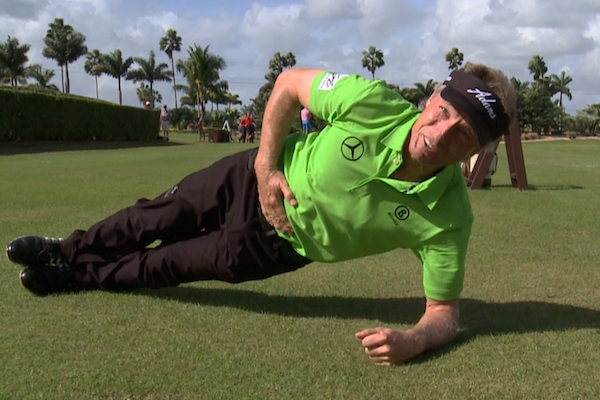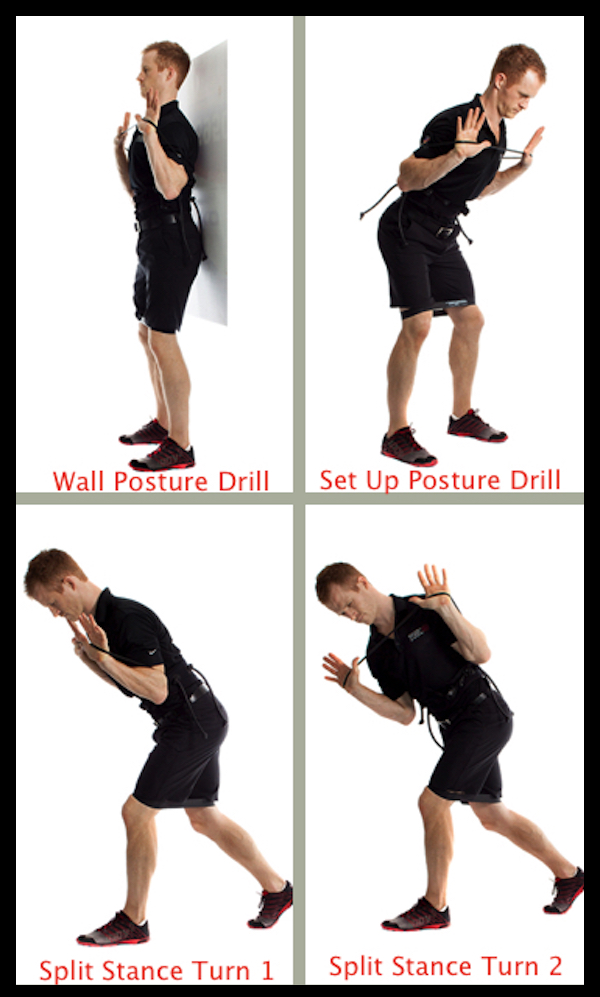Instruction
A Guide to Golf Fitness for Seniors

In this series of five articles, I will be offering guidelines for golf-specific physical activity aimed at five different golfing demographics:
This article, the last in my five-part series, focuses on the backbone of the golfing population: seniors.
The main difference between a younger club golfer and a senior golfer from a lifestyle point of view is that the latter normally has a lot more time to play and practice, which is definitely a positive. It also gives them more time to repeat and ingrain poor movements that are less than ideal, however. When combined with the following physical limitations that normally affect seniors, I’ve seen many of their games go into a decline despite having extra time to practice and play.
Most senior golfers face challenges in the following areas:
- Reduction in mobility: Joints become stiffer and muscles become shorter.
- Muscle atrophy: Less testosterone in the body leads to a wasting of muscle tissue.
- Reduction in bone density: Bone diseases such as osteopenia and osteoporosis lead to increased fragility in the skeletal system.
So what do we prescribe in order to help with these typical issues?
Increasing Mobility
When I train senior golfers, I usually prescribe a combination of spiky ball drills and dynamic stretching that target the following muscles: pectorals, hip flexors, glutes and erector spinae. What I call “soft stretching activities” such as yoga can be extremely beneficial for senior golfers, too.
Here is a mini program for gently increasing hip mobility.
Muscle Atrophy and Bone Density Reduction
These two issues can both be targeted with the same approach: lifting weights. Contrary to popular belief, strength training is neither dangerous nor detrimental for people of advancing age if done properly. In senior citizens, it has been proven to actually stimulate bone re-growth and significantly reduce the rate of muscular atrophy or wastage.
The best type of strength training is closed-chain, load-bearing exercises such as squats, lunges and push-ups. When injury or lack of mobility restricts the participant from making big movements, however, then open-chain, seated exercises such as seated row, chest/shoulder press and leg press will also help.
Poor Movement Patterns
What about those swing faults that just seem to be so deeply ingrained that there is no hope of changing? To start, increased strength and mobility will make it easier to get the body and the club head into a new position. To help break down old movement patterns and learn new ones, we prescribe activation and movement drills that “switch on” the correct muscles and mimic the movement that we want them to make in the golf swing. This is generally done using the Ramsay Posture Belt, among other posture and movement training aids.
Here’s a basic set of exercises than help to promote better posture and begin the journey towards more dynamic rotation.

Three of my favorite drills for posture and learning simple dynamic rotation movement patterns. The equipment used is part of the “Golf Posture Training Kit.”
We also encourage the player to hit a few less balls and do a few more drills, thereby practicing less of the old movement and more of the new one. A 5-1 ball-to-drill ratio is recommended, forcing the player to stop after five shots and practice the new movement pattern, in context, right there in the practice area.
For free access to the exercises detailed in the programs above, check out the Golf Fit Pro App. More info, programs, equipment and services are available on the Golf Fit Pro website.
- LIKE26
- LEGIT0
- WOW2
- LOL0
- IDHT0
- FLOP1
- OB0
- SHANK9
Instruction
Clement: Laid-off or perfect fade? Across-the-line or perfect draw?

Some call the image on the left laid off, but if you are hitting a fade, this could be a perfect backswing for it! Same for across the line for a draw! Stop racking your brain with perceived mistakes and simply match backswing to shot shape!
- LIKE0
- LEGIT0
- WOW0
- LOL0
- IDHT0
- FLOP0
- OB0
- SHANK1
Instruction
The Wedge Guy: The easiest-to-learn golf basic

My golf learning began with this simple fact – if you don’t have a fundamentally sound hold on the golf club, it is practically impossible for your body to execute a fundamentally sound golf swing. I’m still a big believer that the golf swing is much easier to execute if you begin with the proper hold on the club.
As you might imagine, I come into contact with hundreds of golfers of all skill levels. And it is very rare to see a good player with a bad hold on the golf club. There are some exceptions, for sure, but they are very few and very far between, and they typically have beat so many balls with their poor grip that they’ve found a way to work around it.
The reality of biophysics is that the body moves only in certain ways – and the particulars of the way you hold the golf club can totally prevent a sound swing motion that allows the club to release properly through the impact zone. The wonderful thing is that anyone can learn how to put a fundamentally sound hold on the golf club, and you can practice it anywhere your hands are not otherwise engaged, like watching TV or just sitting and relaxing.
Whether you prefer an overlap, interlock or full-finger (not baseball!) grip on the club, the same fundamentals apply. Here are the major grip faults I see most often, in the order of the frequency:
Mis-aligned hands
By this I mean that the palms of the two hands are not parallel to each other. Too many golfers have a weak left hand and strong right, or vice versa. The easiest way to learn how to hold the club with your palms aligned properly is to grip a plain wooden ruler or yardstick. It forces the hands to align properly and shows you how that feels. If you grip and re-grip a yardstick several times, then grip a club, you’ll see that the learning curve is almost immediate.
The position of the grip in the upper/left hand
I also observe many golfers who have the butt of the grip too far into the heel pad of the upper hand (the left hand for right-handed players). It’s amazing how much easier it is to release the club through the ball if even 1/4-1/2″ of the butt is beyond the left heel pad. Try this yourself to see what I mean. Swing the club freely with just your left hand and notice the difference in its release from when you hold it at the end of the grip, versus gripping down even a half inch.
To help you really understand how this works, go to the range and hit shots with your five-iron gripped down a full inch to make the club the same length as your seven-iron. You will probably see an amazing shot shape difference, and likely not see as much distance loss as you would expect.
Too much lower (right) hand on the club
It seems like almost all golfers of 8-10 handicap or higher have the club too far into the palm of the lower hand, because that feels “good” if you are trying to control the path of the clubhead to the ball. But the golf swing is not an effort to hit at the ball – it is a swing of the club. The proper hold on the club has the grip underneath the pad at the base of the fingers. This will likely feel “weak” to you — like you cannot control the club like that. EXACTLY. You should not be trying to control the club with your lower/master hand.
Gripping too tightly
Nearly all golfers hold the club too tightly, which tenses up the forearms and prevents a proper release of the club through impact. In order for the club to move back and through properly, you must feel that the club is controlled by the last three fingers of the upper hand, and the middle two fingers of the lower hand. If you engage your thumbs and forefingers in “holding” the club, the result will almost always be a grip that is too tight. Try this for yourself. Hold the club in your upper hand only, and squeeze firmly with just the last three fingers, with the forefinger and thumb off the club entirely. You have good control, but your forearms are not tense. Then begin to squeeze down with your thumb and forefinger and observe the tensing of the entire forearm. This is the way we are made, so the key to preventing tenseness in the arms is to hold the club very lightly with the “pinchers” — the thumbs and forefingers.
So, those are what I believe are the four fundamentals of a good grip. Anyone can learn them in their home or office very quickly. There is no easier way to improve your ball striking consistency and add distance than giving more attention to the way you hold the golf club.
More from the Wedge Guy
- The Wedge Guy: Golf mastery begins with your wedge game
- The Wedge Guy: Why golf is 20 times harder than brain surgery
- The Wedge Guy: Musings on the golf ball rollback
- LIKE88
- LEGIT15
- WOW6
- LOL1
- IDHT0
- FLOP4
- OB1
- SHANK8
Instruction
Clement: Stop ripping off your swing with this drill!

Not the dreaded headcover under the armpit drill! As if your body is defective and can’t function by itself! Have you seen how incredible the human machine is with all the incredible feats of agility all kinds of athletes are accomplishing? You think your body is so defective (the good Lord is laughing his head off at you) that it needs a headcover tucked under the armpit so you can swing like T-Rex?
- LIKE0
- LEGIT3
- WOW2
- LOL0
- IDHT0
- FLOP0
- OB0
- SHANK2
-

 19th Hole3 weeks ago
19th Hole3 weeks agoJustin Thomas on the equipment choice of Scottie Scheffler that he thinks is ‘weird’
-

 19th Hole2 weeks ago
19th Hole2 weeks ago‘Absolutely crazy’ – Major champ lays into Patrick Cantlay over his decision on final hole of RBC Heritage
-

 19th Hole2 weeks ago
19th Hole2 weeks agoLET pro gives detailed financial breakdown of first week on tour…and the net result may shock you
-

 19th Hole2 days ago
19th Hole2 days agoReport: LIV star turns down PGA Championship invite due to ‘personal commitments’
-

 19th Hole1 week ago
19th Hole1 week agoGary Player claims this is what ‘completely ruined’ Tiger Woods’ career
-

 19th Hole3 weeks ago
19th Hole3 weeks agoTaylorMade signs 15-year-old AJGA Rolex Junior Player of the Year to an NIL contract
-

 Whats in the Bag2 weeks ago
Whats in the Bag2 weeks agoTeam McIlowry (Rory McIlroy, Shane Lowry) winning WITBs: 2024 Zurich Classic
-

 Equipment1 week ago
Equipment1 week agoGolf fans left surprised by LIV’s choice of course for its 2024 individual championship event





















Pingback: Drive Your Game to the Next Level: Senior Golf Fitness Tips – Linked Greens
Dennis Clark
Jul 9, 2015 at 2:56 pm
Great article Nick; I need the senior fitness program!